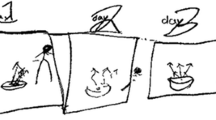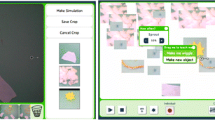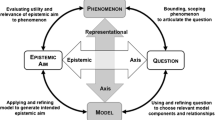Abstract
This article provides an introduction for the special issue of the Journal of Science Education and Technology focused on science teaching and learning with models. The article provides initial framing for questions that guided the special issue. Additionally, based on our careful review of each of these articles, some discussion of how selected articles within the issue informed these questions. Specifically, when considering key facets of modeling instruction or design features of modeling curriculum, the studies in the special issue provided insight into productive ways in which teachers engaged students in modeling practices. Further, modeling pedagogies—pedagogies for transforming scientific practices of modeling into students’ experience—were reified so that how these pedagogies could be coordinated into classroom instruction was revealed. When characteristic features of students’ engagement in modeling were considered, research offered insight into productive model-based learning sequences for K-6 modelers and how students’ development of productive epistemologies can evolve differently. Finally, the special issue considered how technology facilitated cognitive processes and/or instructional practices by examining learners’ interactions with technology within modeling contexts. In this, instructional sequences using agent-based modeling (ABM) as a central technology are shared. These include the role of ABM in scaling student-modeling experiences beyond individuals to classroom experiences and how ABM can support student investigations of complex phenomenon that is not directly observable, among other affordances. Other articles also investigated some aspects of learners’ interactions with technology to inform how technology-enhanced science teaching and learning with models.
Similar content being viewed by others
References
Baek H, Schwarz CV (2014) The influence of curriculum, instruction, technology, and social interactions on two fifth-grade students’ epistemologies in modeling throughout a model-based curriculum unit. J Sci Educ Technol. doi:10.1007/s10956-014-9532-6
Bell P, Bricker L, Tzou C, Lee T, Van Horne K (2012) Exploring the science framework: engaging learners in scientific practices related to obtaining, evaluating, and communicating information. Sci Scope 36(3):17–22
Brady C, Holbert N, Soylu F, Novak M, Wilensky U (2014) Sandboxes for model-based inquiry. J Sci Educ Technol. doi:10.1007/s10956-014-9506-8
Campbell T, Oh PS, Neilson D (2013) Reification of five types of modeling pedagogies with modelbased inquiry (MBI) modules for high school science classrooms. In: Khine MS, Saleh IM (eds) Approaches and strategies in next generation science learning. IGI Global, Hershey, PA, pp 106–126. doi:10.4018/978-1-4666-2809-0.ch006
Cheng M, Brown D (2010) Conceptual resources in self-developed explanatory models: the importance of integrating conscious and intuitive knowledge. Int J Sci Educ 32(17):2367–2392
Clark RE (1983) Reconsidering research on learning from media. Rev Educ Res 53(4):445–459
Delgado C (2014) Navigating tensions between conceptual and metaconceptual goals in the use of models. J Sci Educ Technol. doi:10.1007/s10956-014-9495-7
Fretz EB, Wu HK, Zhang B, Davis EA, Krajcik JS, Soloway E (2002) An investigation of software scaffolds supporting modeling practices. Res Sci Educ 32(4):567–589
Hernández MI, Couso D, Pintó R (2014) Analyzing students’ learning progressions throughout a teaching sequence on acoustic properties of materials with a model-based inquiry approach. J Sci Educ Technol. doi:10.1007/s10956-014-9503-y
Johnson S, Stewart J (2002) Revising and assessing explanatory models in a high school genetics class: a comparison of unsuccessful and successful performance. Sci Educ 86:463–480
Kamarainen AM, Metcalf S, Grotzer T, Dede C (2014) Exploring ecosystems from the inside: how immersive multi-user virtual environments can support development of epistemologically grounded modeling practices in ecosystem science instruction. J Sci Educ Technol. doi:10.1007/s10956-014-9531-7
Khan S (2011) What’s missing in model-based teaching. J Sci Teach Educ 22:535–560
Kozma RB (1991) Learning with media. Rev Educ Res 61(2):179–211
Lee VR (2014) Combining high-speed cameras and stop-motion animation software to support students’ modeling of human body movement. J Sci Educ Technol. doi:10.1007/s10956-014-9521-9
Lee S, Kang E, Kim H-B (2014) Exploring the impact of students’ learning approach on collaborative group modeling of blood circulation. J Sci Educ Technol. doi:10.1007/s10956-014-9509-5
Linn MC (2006) The knowledge integration perspective on learning and instruction. In: Sawyer K (ed) The Cambridge handbook of the learning sciences. Cambridge University Press, New York, pp 243–264
Louca LT, Zacharia ZC (2014) Examining learning through modeling in K-6 science education. J Sci Educ Technol. doi:10.1007/s10956-014-9533-5
Louca T, Zacharia ZC, Constantinou CP (2011) In quest of productive modeling-based learning discourse in elementary school science. J Res Sci Teach 48(8):919–951
Mulder YG, Lazonder AW, de Jong T (2010) Finding out how they find it out: an empirical analysis of inquiry learners’ need for support. Int J Sci Educ 32:2033–2053. doi:10.1080/09500690903289993
Mulder YG, Lazonder AW, de Jong T (2014) Key characteristics of successful science learning: the promise of learning by modelling. J Sci Educ Technol. doi:10.1007/s10956-014-9537-1
National Research Council (2012) A framework for K-12 science education: practices, crosscutting concepts, and core ideas. Committee on a conceptual framework for new K-12 science education standards. Board on Science Education, Division of Behavioral and Social Sciences and Education. The National Academies Press, Washington, DC
NGSS Lead States (2013) Next generation science standards: for states, by states. The National Academies Press, Washington, DC
Oh PS, Oh SJ (2011) What teachers of science need to know about models: an overview. Int J Sci Educ 33(8):1109–1130
Pallant A, Lee H-S (2014) Constructing scientific arguments using evidence from dynamic computational climate models. J Sci Educ Technol. doi:10.1007/s10956-014-9499-3
Ryu S, Han Y, Paik S-H (in press) Understanding co-development of conceptual and epistemic understanding through modeling practices with mobile internet. J Sci Educ Technol. doi:10.1007/s10956-014-9545-1
Snir J, Smith CL, Raz G (2003) Linking phenomena with competing underlying models: a software tool for introducing students to the particulate model of matter. Sci Educ 87(6):794–830
Stewart J, Rudolph J (2001) Considering the nature of scientific problems when designing science curricula. Sci Educ 85:207–222
van Joolingen WR, Aukes AVA, Gijlers H, Bollen L (2014) Understanding elementary astronomy by making drawing-based models. J Sci Educ Technol. doi:10.1007/s10956-014-9540-6
Visintainer T, Linn M (in press) Sixth-grade students’ progress in understanding the mechanisms of global climate change. J Sci Educ Technol. doi:10.1007/s10956-014-9538-0
Wilensky U (1999) GasLab: an extensible modeling toolkit for exploring micro-and-macro- views of gases. In: Roberts N, Feurzeig W, Hunter B (eds) Computer modeling and simulation in science education. Springer, Berlin, pp 151–178
Wilensky U, Reisman K (2006) Thinking like a wolf, a sheep, or a firefly: learning biology through constructing and testing computational theories—an embodied modeling approach. Cognit Instr 24(2):171–209
Wilkerson-Jerde MH, Gravel BE, Macrander CA (2014) Exploring shifts in middle school learners’ modeling activity while generating drawings, animations, and computational simulations of molecular diffusion. J Sci Educ Technol. doi:10.1007/s10956-014-9497-5
Xiang L, Passmore C (2014) A framework for model-based inquiry through agent-based programming. J Sci Educ Technol. doi:10.1007/s10956-014-9534-4
Author information
Authors and Affiliations
Corresponding author
Rights and permissions
About this article
Cite this article
Campbell, T., Oh, P.S. Engaging Students in Modeling as an Epistemic Practice of Science: An Introduction to the Special Issue of the Journal of Science Education and Technology. J Sci Educ Technol 24, 125–131 (2015). https://doi.org/10.1007/s10956-014-9544-2
Published:
Issue Date:
DOI: https://doi.org/10.1007/s10956-014-9544-2




